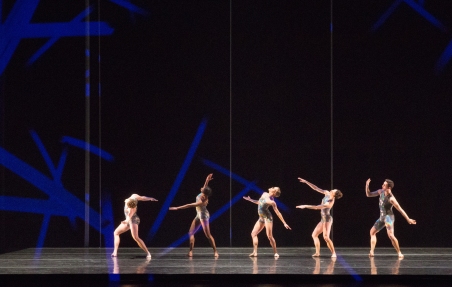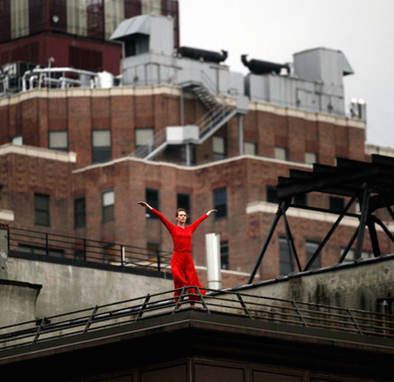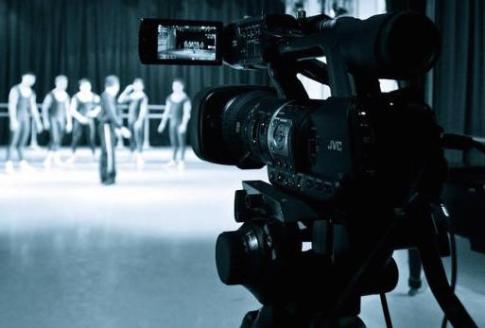It’s when dancing gets awkward that
it starts getting interesting – Merce Cunningham
I have looked at technology as a tool in digital dance installations, however there are an increasing number of choreographers who are choreographing pieces with a technological component built right in for live performance. Of course, most all dance performances include technology: lights and sound. But I wanted to look more closely at the pieces which utilize technology to a larger extent, and discover the effect of this addition.
To begin, I watched an excerpt of BIPED, a piece choreographer by the renowned Merce Cunningham in 1999. The piece has a group of dancers, in shiny silver costumes, perform the dance while moving images are projected behind them and in front of them.
![Merce Cunningham [Misc.]](https://savannahtechnology.files.wordpress.com/2016/02/cunningham-biped.jpg?w=234&h=328)

Martha Graham. For Martha Graham, movement was full of meaning; for Cunningham, it was simply movement. He felt movement should be appreciated for what it was, rather than what it communicated. Dance itself became the subject of his dances.” I found this very surprising. For a man that wanted dance to be valued for the sake of itself, why did he feel the need to add such elaborate digital projections into his choreography? I found a video in which Cunningham and Elizabeth Streb (American dancer and choreographer, and founder of STREB Lab for Action Mechanics) discuss each other’s work. Streb made the comment that Cunningham only does what is necessary for a piece, and “doesn’t leave any decoration…if he sees it as unnecessary, he’ll remove it.” This to me proved the point that to Cunningham, the technology involved in BIPED was absolutely essential. But to an audience member, like myself, I found it distracting.
But, of course, I wasn’t watching the piece in live performance. I watched it while sitting on the floor of my dorm room, drinking from my water bottle and munching on some chocolate. This shows how technology has allowed the audience’s watching experience to

become more personalized. I wanted to look more into this. The first thing to ask, however, is why film dance at all? For Trisha Brown (American dancer and choreographer, and founder of Trisha Brown Dance Company), filming dance is essential for her site-specific work like Roof Piece, a 1971 creation where dancers performed on rooftops. For site-specific choreographers, filming their work allows it to be seen by a larger audience than the people who happen upon these presentations by accident. Dance is also filmed to make dance films and documentaries. These often attempt to capture a process of some sort, such as the dancer’s life journey, or the choreographer’s inspiration for the piece. Why are these important? Well, they are sort of like the “bonus features” of the dance performance, giving more insight into how the finished product came to be. Lastly, dance is filmed for documentation or education. We like to remember what our hard earned effort looks like, and so do choreographers and dancers! They want to be able to look back and remember the performance for the sake of itself, or in order to re-stage it exactly. This seems logical.
So now I know why dance is filmed, but now to examine how. The obvious answer is a video-camera. But, the experience of watching dance on film versus dance on stage can be wildly different. I read an article by Carrie Seidman, who wrote a dance review of the film series Ballet In Cinema, and compared it to the experience of watching the same pieces live in performance. She posed the question: “Can a filmed ballet ever compare with the real thing?” She concluded yes and no. Watching dance on film, she said, can be interesting as it can offer perspectives and angles of the piece that aren’t readily available or accessible when watching from a chair in the audience. She also talked about how the film series had commentary in the background, offering facts and insight into each piece (which obviously you don’t have in a live performance). But, she points out how film leaves some things out. From the film she couldn’t see the sweat rolling off the backs of the dancers as they smilingly complete an inhuman feat, nor did she feel the ambiance of the theater hall. I stopped for a moment when I read this, but I know exactly what she means. When I go see professional dance companies perform, there’s a  certain feeling of importance and excellence that hangs in the air, a feeling that would not be possible without the energy of an audience of real people and a cast of real dancers. Seidman also said that she was skeptical of the film’s authentic capture of the pieces, noting how she could’t tell if the filmmaker had manipulated the timing in one section to make it seem more impressive. Finally, she said that even though film provides some handy tools to see the performance in a different way, live performance puts, “me in control; I can both see the bigger picture and chose where I allow my eye to travel.” This is probably the most essential difference between dance on film and dance live. When you watch dance on film, you completely surrender your freedom of gaze to the person filming: they choose where to focus the camera, whether to zoom in or out, and whether to cut out sections that they deem unnecessary. Our entire view depends on the person who films the dance, so much so that two pieces can look completely different based on choices made by the videographer. For example, I went on YouTube and looked up William Forsythe’s In the Middle, Somewhat Elevated, and watched two different clips of the same piece but by different dance companies: Tulsa Ballet and Pacific Northwest Ballet. Now, if you watch these clips you’ll find that besides from obvious differences, like the specific dancers and the duration of the clip, the entire feel of the dance is different. In the Tulsa Ballet clip, the dance is filmed from a stationary position, and set to see the whole stage at once. It makes the dancers look smaller, and it’s harder to see their facial expressions and small technical details of their performance, however you can easily see their relationships to other dancers in space. The PNB clip is filmed entirely differently, for the camera is up close, it is narrowed in on just two dancers, and it moves with them. The camera person in the Tulsa Ballet clip also took creative liberties by snipping sections and crafting a video of only certain parts, while PNB’s clip kept all pieces intact. So why does this matter? For me, I feel that as an audience member, even one who is witnessing dance through the screen of my laptop, I should be aware that the video I’m watching is a product of forced viewing. My eyes only see what the camera allows me to take in, and this limitation is an aspect of technology’s influence in dance. Should we feel frustrated by this limitation? We can, or we can see it as the camera person’s own creative expression, as they are trying to produce art just like choreographers and dancers.
certain feeling of importance and excellence that hangs in the air, a feeling that would not be possible without the energy of an audience of real people and a cast of real dancers. Seidman also said that she was skeptical of the film’s authentic capture of the pieces, noting how she could’t tell if the filmmaker had manipulated the timing in one section to make it seem more impressive. Finally, she said that even though film provides some handy tools to see the performance in a different way, live performance puts, “me in control; I can both see the bigger picture and chose where I allow my eye to travel.” This is probably the most essential difference between dance on film and dance live. When you watch dance on film, you completely surrender your freedom of gaze to the person filming: they choose where to focus the camera, whether to zoom in or out, and whether to cut out sections that they deem unnecessary. Our entire view depends on the person who films the dance, so much so that two pieces can look completely different based on choices made by the videographer. For example, I went on YouTube and looked up William Forsythe’s In the Middle, Somewhat Elevated, and watched two different clips of the same piece but by different dance companies: Tulsa Ballet and Pacific Northwest Ballet. Now, if you watch these clips you’ll find that besides from obvious differences, like the specific dancers and the duration of the clip, the entire feel of the dance is different. In the Tulsa Ballet clip, the dance is filmed from a stationary position, and set to see the whole stage at once. It makes the dancers look smaller, and it’s harder to see their facial expressions and small technical details of their performance, however you can easily see their relationships to other dancers in space. The PNB clip is filmed entirely differently, for the camera is up close, it is narrowed in on just two dancers, and it moves with them. The camera person in the Tulsa Ballet clip also took creative liberties by snipping sections and crafting a video of only certain parts, while PNB’s clip kept all pieces intact. So why does this matter? For me, I feel that as an audience member, even one who is witnessing dance through the screen of my laptop, I should be aware that the video I’m watching is a product of forced viewing. My eyes only see what the camera allows me to take in, and this limitation is an aspect of technology’s influence in dance. Should we feel frustrated by this limitation? We can, or we can see it as the camera person’s own creative expression, as they are trying to produce art just like choreographers and dancers.
I am certainly grateful for films of dance, for without them I would have never been exposed to such a wide range of choreography. Dance performances are expensive, time consuming, and involve planning. Technology has allowed people to watch dance without leaving their homes or spending a dime. But, audiences no longer have to follow the tacit dance performance-watching-etiquettethat is required when seeing a live performance. Now, we can multi-task: watch a YouTube video while making dinner, texting a friend, or surfing the web for the perfect vacation spot. Is this freedom taking away from the dance? Is the technology used to create the figure projections taking away from the clean lines of Cunningham’s human dancers? In my opinion, it does. But I think it also comes down to how much we let ourselves be distracted. Because ultimately, distraction leads our viewing and decides what we think is important. Something to think about..
- Links:
- Videos:
- BIPED: https://www.youtube.com/watch?v=YHeoYdDMbLI
- Cunningham and Streb: https://www.youtube.com/watch?v=DKe-WjNZCtI
- Photos:
- (top): http://artsedge.kennedy-center.org/students/features/master-work/cunningham-biped
- (middle): http://discover.juilliard.edu/juilliard-dance-performance-opportunities
- (middle 2): http://dailyserving.com/2013/04/trisha-brown-in-los-angeles/
- (bottom): http://www.artsprofessional.co.uk/magazine/271/case-study/live-streaming-explored
